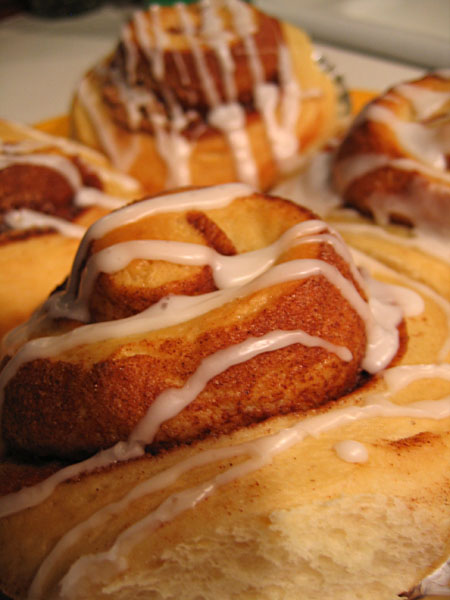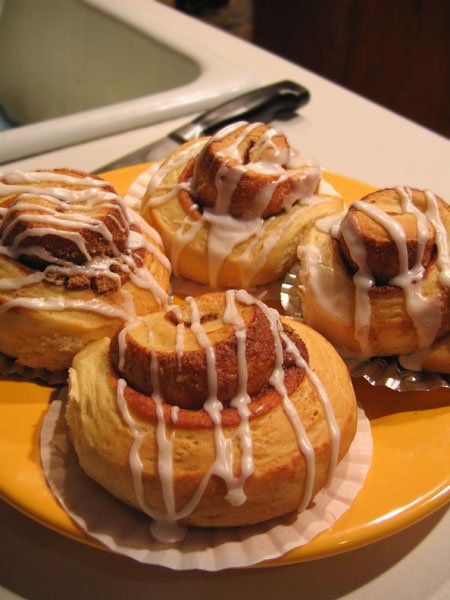

Hello,
Here is a great recipe for not to sweet but delicious cinnamon buns. If anyone else has any good recipes please let me know. I am looking for something ideally a little flakier than this and more along the lines of a danish spiral, but with a cinnamon filling. Enjoy the recipe!
Skylar
BBA Cinnamon Buns (adapted from Peter Reinhart)
3.25 oz granulated sugar
.25oz salt
2.75oz butter or shortening (at room temperature)
1 large egg (1.65oz) slightly beaten
1 tsp lemon extract or 1tsp lemon zest
16oz unbleached bread flour or all-purpose flour
2 tsp (.22oz) instant yeast
9-10oz whole milk or buttermilk at room temperature or 1oz dry milk and 8oz water
½ cup cinnamon sugar (6 ½ Tbsp sugar plus 1 ½ Tbsp cinnamon)
Mix together the sugar, salt, and shortening on medium-high speed in an electric mixer with a paddle attachment. The recipe said to "cream" them, so I mixed them until they seemed smooth and well blended. I never liked the word "cream", because it always seems so ambiguos as to how thoroughly the mixture should be blended. If you are using the powdered milk, mix the milk with the sugar, but add the water with the flour and yeast. Mix in the egg and lemon extract until blended. Then add the flour, yeast, and milk. Mix on low speed (or stir by hand) until the dough forms a ball. Switch to the dough hook and increase the speed to medium, mixing for approximately 10 minutes, or until the dough fairly smooth, tacky but not sticky (I wound up adding a little extra flour to make the dough not stick to my hands completeley. You may have to add a little flour or water while mixing to achieve this consistancy. The dough should pass the windowpane test (and it did!) and register 77F to 81F on your fancy little thermometer (I wish I had a thermopen so I wouldn't have to wait a half minute for a reading!) Lightly oil a large bowl and turn the dough in the bowl to coat with oil to prevent a skin from forming. Cover the bowl with plastic wrap. Ferment at room-temp for approximately 2 hours, or until the dough doubles in size. Mist the counter with spray oil and proceed as follows
Roll the dough out into a rectangle 2/3 inch thick and 14 inches wide by 12 inches long for large buns or 18 inches wide by 9 inches long for small buns. Don’t roll the dough too thin or it won't be soft and tender like a cinnamon bun should be. Sprinkle the cinnamon sugar over the dough and roll the dough into a log (I like to roll in towards myself so the finished roll is right in front of me). With the seam down cut the roll into 8-12 pieces for larger buns or 12-16 pieces for smaller buns. Place the buns approx ½ inch apart so that they are not touching but are close to one another. Proof at room temperature for 75 to 90 minutes, or until the buns have grown into one another and have nearly doubled in size. You can retard the buns in the refrigerator for a couple days supposedly. I baked them straight away. Bake the buns at 350F for 20-30 minutes or until they are lightly brown. Cool the buns in the pan for about 10 minutes and then smear or drizzle the glaze over the top of the buns. To make the glaze combine: 4 cups sifted 10x sugar with 1 tsp lemon extract or juice and about ½ cup warm milk. Enjoy the buns! (Preferably the day they are baked, they stale pretty quickly!)
Notes:
I had to add a bit of extra flour (quite a bit actually) to make the dough workable. This could be because I used A.P flour versus bread flour, hence lower absorption.
You can put raisins and nuts into your buns!
I used 1% milk versus whole milk. Is there a difference? I can’t tell you that, perhaps you can tell me!
I use a similar dough, but do a few things different. 1.) I use baker's dry milk. You can do the same thing by scalding your fresh milk. This helps the amount of rise quite a bit. 2.) I use bread flour and a rather high hydration -- about 72 percent. This makes the dough hard to work with but with enough stretch and folds it works for me. 3.) I use brown sugar -- like the taste better. 4.) No lemon. and 5.) I use a starter with about 1/3 of the flour at a 80 percent hydration mixed the night before. I think this is important to the flavor and the open crumb. My starter is just flour, water, and a small amount of instant yeast - 1/4 tea.
Adding extra flour to make the dough "workable" is in the wrong direction I think for what you want. I understand your using AP -- but I would keep the higher hydration levels and just add more stretch and folds. YMMV
Dave
Dave thanks for your thoughts. Do you have any recipes that you reccomend?? As for the flour, the Reinhart recipe stated that the dough should not be sticky. I flour added only to the point where the dough would not cling completeley to the workbowl or my finger, but was still very tacky. What should I be looking for?? It is tricky to roll the dough out if it is too wet, even if the counter is well oiled! I would appreciate any advice!
Skylar
My dough might be a little sticky but I think that if it is developed enough this isn't a problem. As to a work surface I use a baking mat that I cover with a thin layer of Crisco and then dust with flour. I find that doing this I have very little sticking problem except when first starting with the dough. After a few cycles of stretch and fold it doesn't stick at all. (I stretch and fold -- doing a 4 fold maybe twice or three times and then letting it rest for 15 to 20 minutes -- followed by some more stretch and fold. During the rest times I am cleaning the kitchen or reading the paper etc.) I think you could just put the Crisco on the counter and dust with flour too -- put I have never tried this. For rolling this out I use a silicon cover rolling pin but dust it well with flour as I start. After rolling a bit I let it rest for about 5 minutes and then roll some more. I really don't have a sticking problem at this point at all.
One last point, I do think that the use of either scaled milk or baker's dry mill helps a lot in the lightness of the rolls. If you look at old bread books or cook books they always called for scalding the milk. Baker's dry mill does the same thing -- it effects the proteins in the milk than limit the rise in the dough. While I am mad at King Arthur for their very high prices their Baker's dry milk is a very good product. (Baker's dry milk is heated to a high temperature before the drying process.)
Dave
Irish blogger at Good Mood Food Blog has a great recipe for Swedish Cinnamon Buns that comes highly recommended. If you go to his site and go to the bottom of the screen where he displays his favorite recipes one of them is for the Swedish cinnamon buns. It looks as if it would work well for you.
http://www.thegoodmoodfoodblog.com/2007/10/kanel-bulle-swedish-cinnamon-buns.html
Good and not too sweet.